Losing a limb is a life-changing event, and the road to recovery can feel overwhelming. One of the biggest questions people have after an amputation is, “How long will it take to get back to normal?” The answer is different for everyone, but rehabilitation is a crucial step in regaining independence.
Rehabilitation is not just about healing the wound—it’s about rebuilding strength, learning to use a prosthetic (if needed), and adapting to a new way of life. Some people recover faster than others, but the key to a smooth rehabilitation is patience, persistence, and the right support.
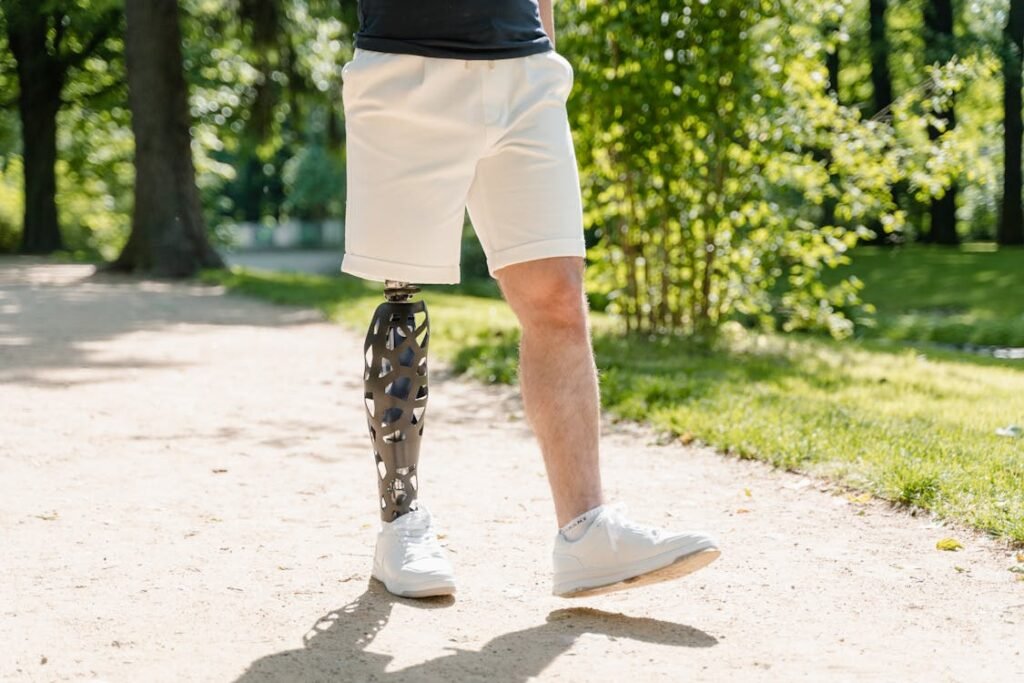
Understanding the Rehabilitation Timeline
Rehabilitation after an amputation is not a single event but a series of stages. Each stage focuses on different aspects of recovery, from healing the wound to learning to use a prosthetic limb.
The entire process can take anywhere from a few months to over a year, depending on factors like overall health, the level of amputation, and commitment to therapy.
The First Few Weeks: Healing and Initial Recovery
In the first few weeks after surgery, the main focus is healing the wound and preventing complications. The body needs time to adjust, and doctors closely monitor for infections, swelling, and pain.
Managing pain is a priority because discomfort can make it harder to move and participate in early rehabilitation.
During this phase, doctors and physical therapists start working on stump care and gentle movement exercises to maintain circulation and prevent stiffness.
It’s common to experience phantom limb sensations, where the brain still feels the missing limb. While this can be unsettling, it is a normal part of the healing process and can be managed with medications and therapy.
Emotional well-being is just as important as physical recovery. Many people experience feelings of loss, frustration, or sadness. Support from family, friends, and professionals can make a big difference in adjusting to this new reality.
Speaking with a rehabilitation specialist or counselor early in the process can help ease emotional challenges.
Weeks to Months: Strengthening and Preparing for a Prosthetic
As the wound heals and pain becomes more manageable, rehabilitation moves to the next stage. Building strength and improving balance become the focus.
Without a limb, the body must work harder to maintain stability. Physical therapy helps strengthen muscles, improve coordination, and prepare the body for a prosthetic limb.
During this phase, a prosthetist evaluates whether the residual limb is ready for a prosthetic fitting. This depends on how well the stump has healed, whether swelling has reduced, and if there is enough strength to support a prosthetic.
If a prosthetic is an option, the next step is a temporary socket fitting to help the individual get used to the sensation of wearing and using an artificial limb.
If someone chooses not to use a prosthetic, therapy still continues with a focus on adapting to everyday activities. Occupational therapists teach techniques to perform tasks independently, using assistive devices if needed.
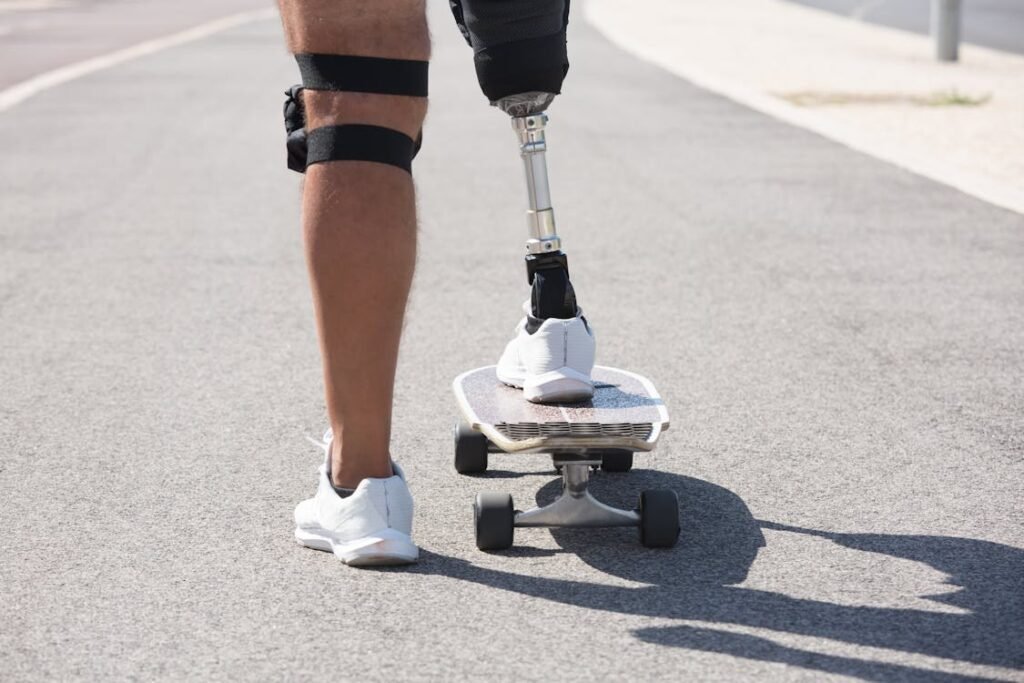
Adapting to a Prosthetic Limb and Regaining Mobility
Once the residual limb has healed and is ready for a prosthetic, the next stage of rehabilitation begins. This is a critical period that requires patience, as learning to use a prosthetic limb is not an instant process.
The body must adjust to the weight and feel of the artificial limb, and this takes time. Many people experience initial discomfort or awkwardness when using a prosthetic, but with consistent practice, it becomes more natural.
The First Steps with a Prosthetic Limb
The first prosthetic fitting is an exciting yet challenging moment. A trained prosthetist ensures the fit is correct and comfortable. A poorly fitted prosthetic can cause skin irritation, pain, and even long-term issues with posture and movement.
Frequent adjustments are often necessary in the beginning because the residual limb continues to change shape as healing progresses.
Physical therapy plays a huge role at this stage. Therapists guide individuals through exercises to build strength, improve balance, and learn proper walking techniques. In the beginning, movements may feel slow and difficult, but repetition and perseverance help build confidence.
Walking on different surfaces, climbing stairs, and even standing for long periods all require practice. Each small victory brings more independence and mobility.
Beyond walking, therapy also focuses on daily activities like sitting, standing, and reaching for objects. These simple tasks, which once felt effortless, require a new approach when using a prosthetic.
Occupational therapists help individuals find the best ways to perform daily routines with ease.
Overcoming Challenges and Building Confidence
Adjusting to a prosthetic limb isn’t just about physical rehabilitation—it’s also about mental and emotional adaptation. Frustration and discouragement are common, especially when progress feels slow.
Support from healthcare professionals, peers, and loved ones is essential during this period. Many find motivation through support groups or by connecting with others who have successfully adapted to life after amputation.
Phantom limb sensations may still be present, and some individuals experience phantom limb pain. This can be managed through therapies such as mirror therapy, massage, or even specialized medication.
Learning how to handle these sensations can make the rehabilitation process smoother.
Regular follow-ups with the prosthetist ensure that the prosthetic remains comfortable and functional. Over time, the body changes, and adjustments may be necessary.
Some people transition to more advanced prosthetics with additional features, such as myoelectric hands or running blades, as their confidence grows.
The key to long-term success is persistence. The more a person practices and uses their prosthetic in daily life, the more natural it feels. With dedication, many individuals return to work, hobbies, and even sports, proving that life after amputation can be just as fulfilling as before.
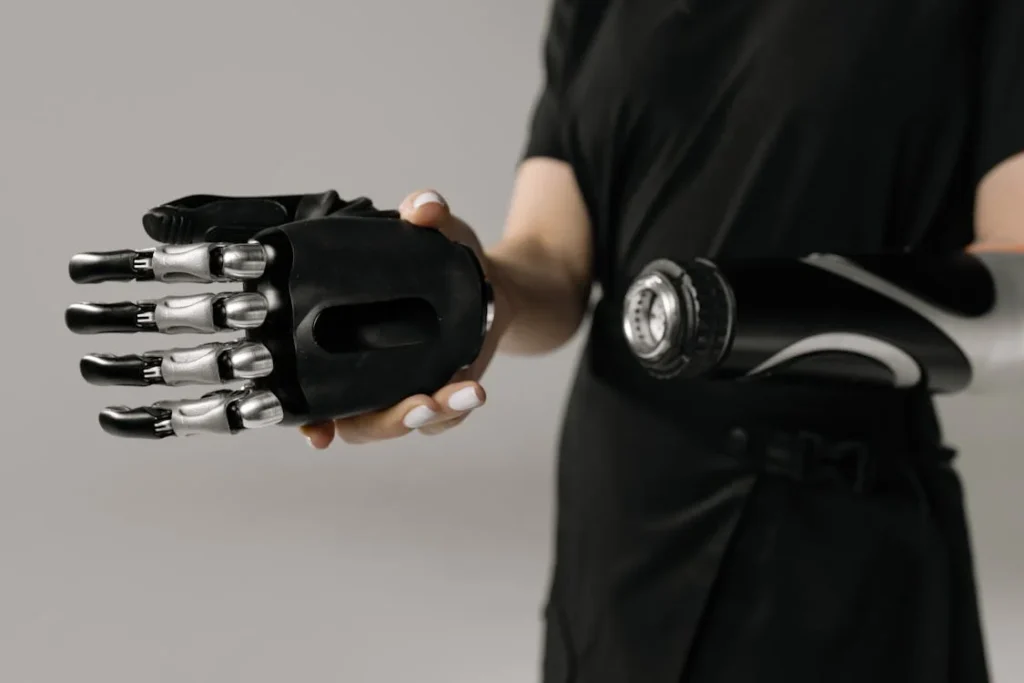
Long-Term Rehabilitation and Lifestyle Adaptation
Rehabilitation does not end once a person learns to walk or perform daily tasks with a prosthetic. True recovery goes beyond the physical—it includes adapting to a new way of life, maintaining long-term health, and staying active.
This phase of rehabilitation varies from person to person and can last several months to years, depending on individual goals and lifestyle choices.
Staying Active and Maintaining Strength
Even after the initial rehabilitation process, ongoing physical therapy and exercise remain essential. The body needs continuous strengthening to support mobility and prevent complications.
Muscle imbalances can develop if one side of the body is working harder than the other, which can lead to posture issues and joint pain. A well-structured exercise plan helps maintain overall balance and flexibility.
For those using a prosthetic, regular movement helps improve coordination and reduces stiffness. Walking, swimming, and yoga are often recommended as they promote circulation and prevent muscle loss.
Those who were active before amputation can still engage in sports with the right modifications. Many people with limb loss participate in activities like cycling, running, and even rock climbing with the help of adaptive prosthetics.
Managing Prosthetic Fit and Comfort
The body changes over time, which means a prosthetic that fit perfectly at first may need adjustments later. Changes in weight, muscle tone, or residual limb shape can affect how the prosthetic feels.
Discomfort, redness, or skin irritation are signs that a new fitting or modification may be required.
Regular visits to a prosthetist help ensure that the device remains comfortable and functional. Some individuals eventually transition to more advanced prosthetic models that offer greater flexibility and features.
Whether it’s a bionic hand with improved grip control or a high-performance running blade, upgrading a prosthetic can enhance daily life.
Psychological Well-being and Emotional Support
Rehabilitation is not just about physical recovery. Emotional adaptation is an ongoing process that requires self-acceptance and a positive mindset.
Some people struggle with body image concerns, loss of independence, or fear of being judged. These feelings are completely normal, but support systems play a key role in overcoming them.
Counseling, peer support groups, and community programs can provide encouragement. Speaking with others who have gone through a similar journey helps individuals feel less alone.
For many, helping others by sharing their experiences or mentoring new amputees can be a fulfilling way to give back.
Living Life to the Fullest
Life after an amputation may require adjustments, but it does not mean giving up on dreams and goals. Many people return to their careers, start new hobbies, or even take up adventurous activities they never considered before.
With the right mindset, support, and technology, individuals can continue to lead active, fulfilling lives.
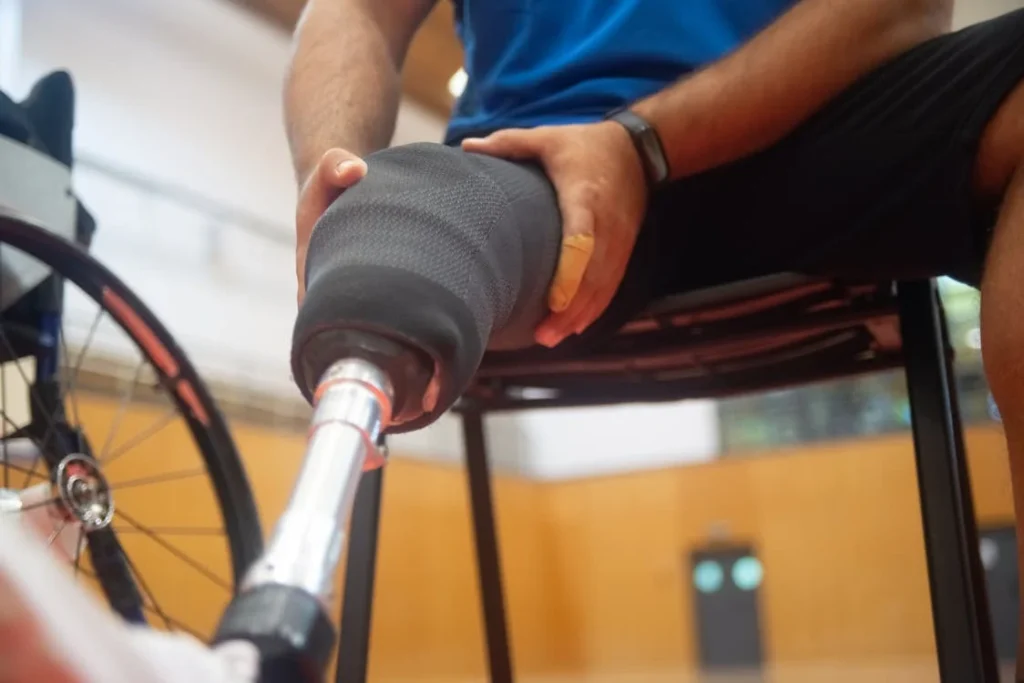
The Role of Rehabilitation Technology in Recovery
Advancements in prosthetic technology and rehabilitation methods have transformed the recovery process for amputees. Modern prosthetics are lighter, more comfortable, and more functional than ever before, making adaptation smoother.
Additionally, rehabilitation techniques such as gamified therapy, virtual reality, and artificial intelligence-driven prosthetic training have made rehabilitation more engaging and effective.
Gamified Rehabilitation: Making Therapy Engaging
One of the biggest challenges in rehabilitation is staying motivated, especially when progress feels slow. Traditional therapy exercises can become repetitive and discouraging. Gamified rehabilitation introduces an element of fun by turning exercises into interactive challenges.
At Robobionics, we offer home-based gamified rehabilitation programs to help users develop muscle control and coordination while keeping them engaged.
By incorporating game-like tasks, users can practice movements in an enjoyable way, making therapy feel less like a chore and more like a rewarding experience. This approach improves consistency, which is essential for faster recovery.
Smart Prosthetics: Enhancing Mobility and Independence
The development of bionic limbs with sensory feedback is changing how people experience prosthetics. Traditional prosthetics provide mobility but lack a sense of touch.
With advanced technology like Grippy™, our lightweight and ergonomic bionic hand, users can experience improved grip control and even detect pressure differences.
Myoelectric prosthetics, which respond to muscle signals, allow for more natural movement. Instead of relying on mechanical controls, these devices use sensors to interpret electrical impulses from muscles, enabling users to open, close, and move their prosthetic limb effortlessly.
This innovation helps individuals perform daily tasks with greater ease and confidence.
Virtual Reality and AI in Prosthetic Training
Virtual reality (VR) is making waves in rehabilitation by helping users practice movements in a simulated environment.
With VR training, individuals can engage in real-world scenarios—such as picking up objects or walking on different terrains—before applying those skills in daily life. This approach reduces fear and hesitation, allowing for a smoother transition to using a prosthetic.
Artificial intelligence (AI) is also being integrated into modern prosthetics, making them more adaptive. AI-powered limbs can learn from a user’s movement patterns, improving functionality over time.
This personalization makes prosthetics feel more like a natural part of the body rather than an external device.
Faster Recovery Through Innovation
With the right combination of rehabilitation programs and modern technology, recovery times can be significantly reduced. By using tools like gamified rehabilitation and AI-driven prosthetics, individuals can regain independence faster and with more confidence.
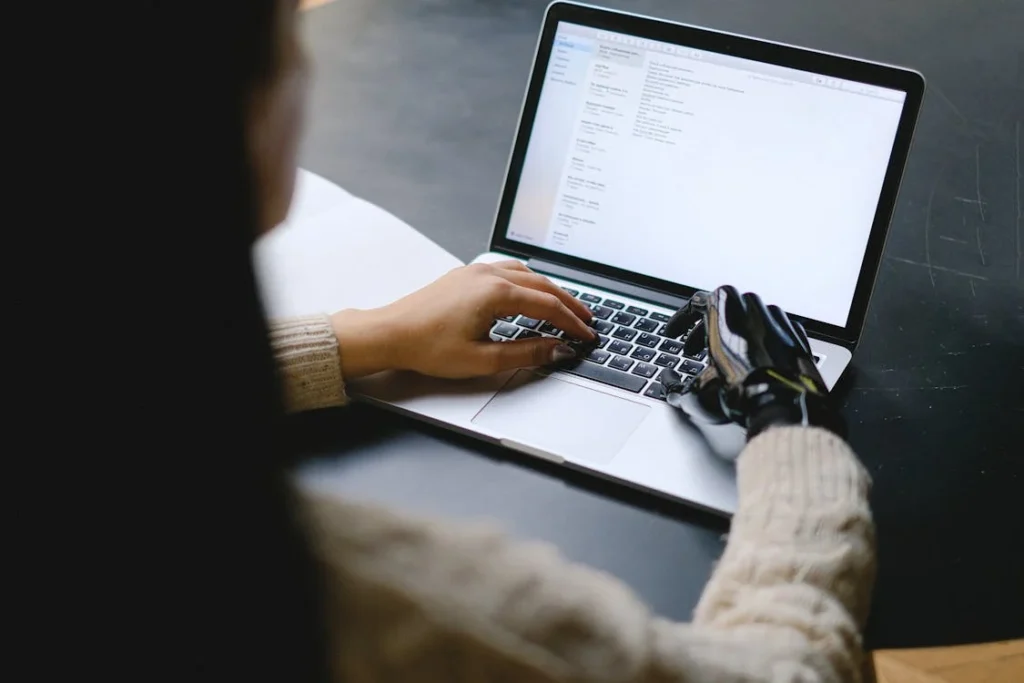
The Importance of a Strong Support System During Rehabilitation
Rehabilitation is not just about medical care and physical therapy—it is also deeply influenced by emotional support and encouragement from family, friends, and professionals.
Recovering from an amputation can feel isolating at times, but a strong support system can make a huge difference in the healing process.
Family and Friends: The First Line of Support
Loved ones play an essential role in rehabilitation, not just physically but emotionally. They provide encouragement, assist with daily activities, and help maintain a positive outlook.
It is important for family members to be patient and understand that rehabilitation is a long process that requires mental strength, reassurance, and motivation.
For some, adjusting to life with an amputation can bring frustration, self-doubt, or even moments of sadness. Family members can help by listening, offering practical assistance, and celebrating small victories.
Simple actions, such as acknowledging progress and encouraging independence, can boost confidence and motivation.
The Role of Rehabilitation Specialists
Beyond family, trained professionals guide the rehabilitation journey. Physical therapists, occupational therapists, and prosthetists work together to create a personalized recovery plan.
These experts teach essential movement techniques, provide prosthetic training, and ensure long-term health by preventing complications like joint stiffness or muscle imbalances.
A prosthetist is especially important for individuals using a prosthetic limb. They customize the fit, make necessary adjustments, and provide guidance on how to use and maintain the device.
Regular check-ins with a prosthetist help ensure comfort and functionality, preventing issues such as skin irritation or pressure sores.
Peer Support and Community Networks
Connecting with other amputees can be incredibly empowering. Many individuals find comfort in hearing the experiences of those who have gone through a similar journey.
Support groups, online forums, and community events provide a space to share challenges, ask questions, and celebrate progress together.
Some individuals also choose to work with peer mentors—people who have successfully adapted to life after an amputation and can offer guidance.
These mentors provide practical advice, encouragement, and firsthand insights on how to navigate daily life with a prosthetic or without one.
Psychological Support for Emotional Well-Being
Mental health is just as important as physical health in rehabilitation. Counseling and therapy can help individuals manage emotions like grief, frustration, or anxiety.
Professional therapists offer strategies to cope with challenges, build resilience, and maintain a positive mindset.

Nutrition and Overall Health in Rehabilitation
The body needs proper nutrition to heal wounds, strengthen muscles, and restore energy levels after an amputation. What a person eats directly affects their rehabilitation progress, influencing everything from tissue repair to energy levels and immune function.
The Role of Nutrition in Healing
Right after surgery, the body requires high-protein foods to rebuild muscle and repair tissues. Proteins help form new skin cells, prevent infections, and promote overall healing. Good sources of protein include eggs, fish, chicken, lentils, beans, and dairy products.
Vitamins and minerals also play a significant role in the healing process. Vitamin C, found in citrus fruits, helps the body produce collagen, which is essential for wound healing.
Vitamin D and calcium, found in dairy and leafy greens, help maintain strong bones, which is particularly important for people who rely more on their remaining limbs.
Maintaining a Healthy Weight for Mobility
For individuals using a prosthetic limb, maintaining an optimal weight is important. A sudden weight gain or loss can affect the fit of a prosthetic, leading to discomfort or difficulty walking. Keeping a balanced diet helps ensure that the body remains strong and mobile.
Staying hydrated is another key factor in recovery. Drinking enough water helps prevent muscle cramps, promotes circulation, and keeps energy levels stable.
Long-Term Health and Lifestyle Choices
Good nutrition is not just important during the early recovery phase—it remains essential throughout life. Eating a balanced diet supports energy levels, mobility, and overall well-being.
Those who maintain an active lifestyle and make healthy food choices are more likely to experience better prosthetic function, improved mobility, and greater independence in the long run.
At Robobionics, we encourage individuals to focus on their overall well-being by making lifestyle choices that support long-term success. Rehabilitation is not just about learning to walk again—it’s about creating a foundation for a strong, healthy, and fulfilling life.

Returning to Work and Daily Activities
One of the biggest concerns for many amputees is when and how they can return to work and everyday activities.
The timeline for resuming work depends on the type of job, level of amputation, and overall recovery progress. While some people return within a few months, others may take longer to adjust.
Preparing for the Workplace
Before going back to work, it is important to regain confidence in mobility and task performance. Occupational therapists help individuals adapt to workplace tasks, ergonomics, and necessary modifications.
Some may need adaptive tools, while others may benefit from a customized prosthetic suited for their profession.
Employers are often supportive when it comes to accommodating the needs of an amputee. Laws protecting individuals with disabilities ensure equal access to job opportunities, workplace modifications, and flexible work arrangements.
Speaking with an employer about any necessary adjustments can make the transition smoother.
Resuming Household and Social Activities
Beyond work, many individuals wonder when they can get back to household chores, hobbies, and social outings. The answer depends on how well they have adapted physically and emotionally.
Simple daily tasks such as cooking, cleaning, or shopping may require new approaches. Occupational therapists teach adaptive techniques to make these tasks easier. Many household activities can be modified using assistive tools that improve grip strength or mobility.
Social life is another essential part of recovery. Staying connected with family and friends helps improve mental well-being and confidence. Attending events, traveling, and engaging in hobbies all contribute to a sense of normalcy and independence.
Conclusion
Rehabilitation after an amputation is a journey that takes time, patience, and the right support. While the timeline varies for each person, the ultimate goal remains the same—regaining independence and living a fulfilling life. From healing and therapy to adapting to a prosthetic and returning to daily activities, each step brings new challenges and victories.
With advancements in prosthetic technology, gamified rehabilitation, and expert support, recovery is smoother and more effective than ever before. The key is persistence—the more you practice and engage in rehabilitation, the more confident and independent you become.
At Robobionics, we are dedicated to helping individuals navigate this journey with innovative, comfortable, and affordable prosthetic solutions. Whether you need a bionic hand like Grippy™, home-based rehabilitation support, or expert guidance, we are here to help.



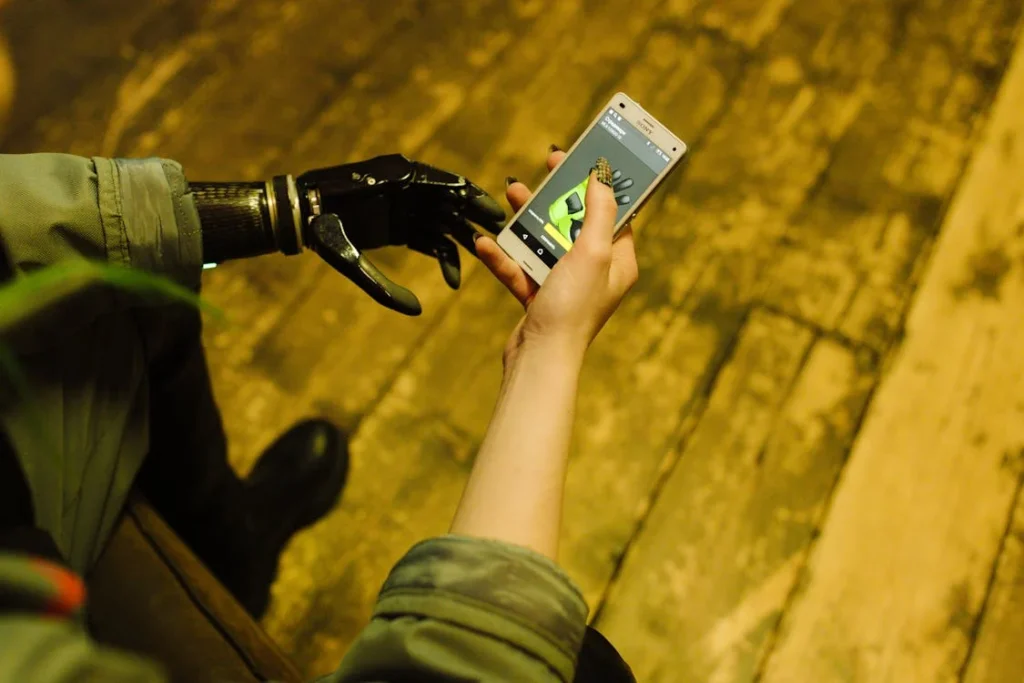
Great explanation, easy to understand! keep sharing.